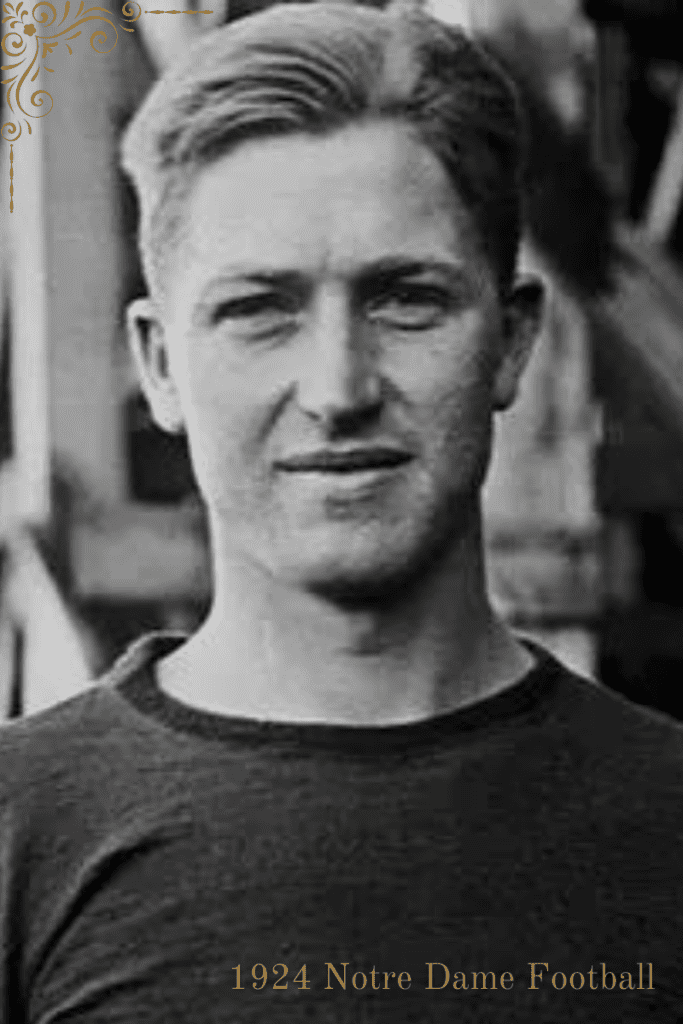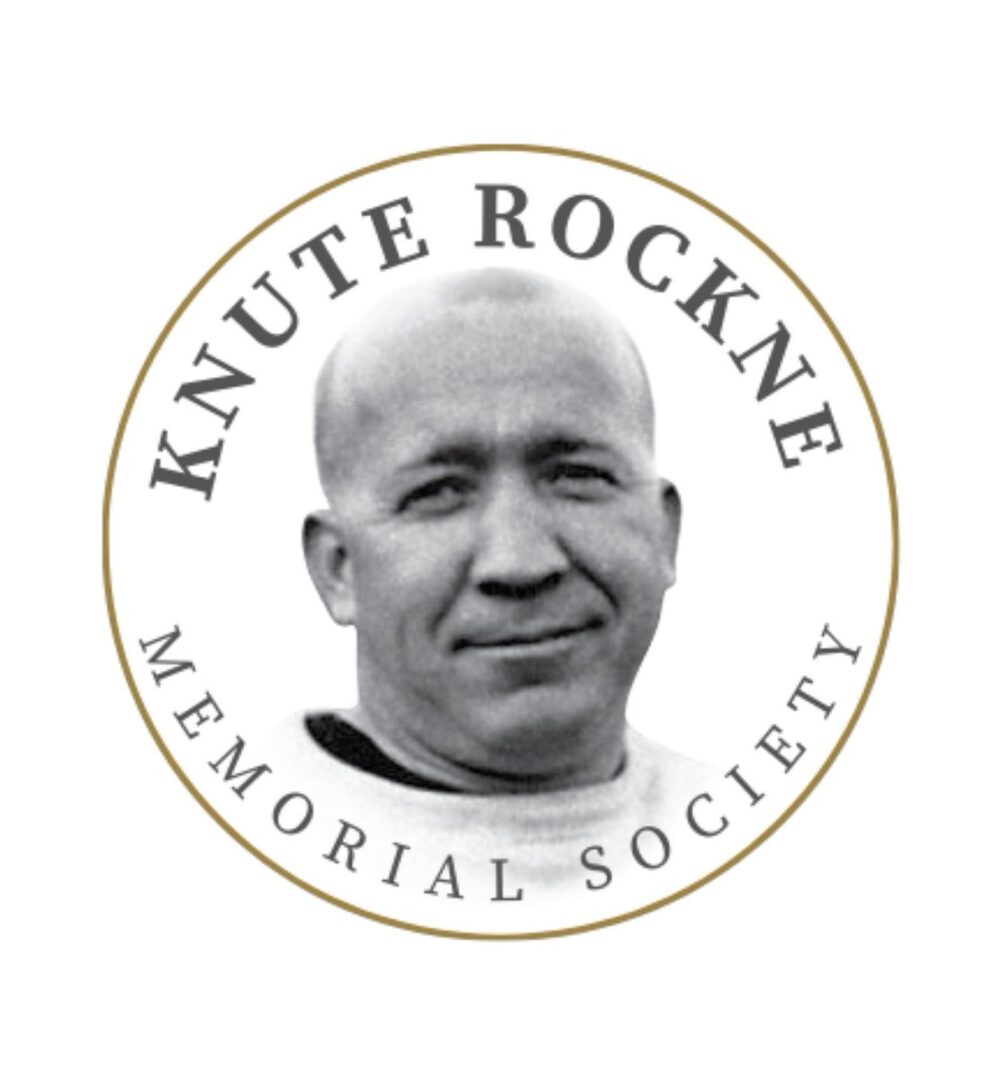
Adam Walsh
Center & Captain
Hollywood, CA
Coach Knute Rockne knew that his backfield, especially in 1924, would garner special attention. He preferred that a lineman be elected captain of the Fighting Irish and was delighted when senior center Adam Walsh won that honor.
Adam Walsh’s life was one of achievement from California to Maine. His 1968 induction into the College Football Hall of Fame recognized his outstanding contributions to the game.
Adam Walsh III was born on December 4, 1901, at the country crossroad town of Churchville, Iowa, located about 15 miles south of Des Moines. His father, Adam Jr., was a first-generation American whose parents emigrated from Ireland during the potato famine of the late 1840s. In Churchville, Adam Walsh, Jr. operated a general store.
In 1906, the family followed a familiar American theme and struck out for southern California, leaving behind Churchville and numerous Walsh relatives. Adam Jr. and his wife Stella built a home in the village of Hollywood, in an area with few other houses. The Walsh children played in a large, fenced yard where they would occasionally see deer and mountain lions wandering down from the nearby hills.
Young Adam’s father began working as a clerk in a grocery store, and before long, he had become co-owner of “Walsh & Mackie Groceries,” located on Prospect Avenue, just east of Vine Street. The area was becoming famous for the budding motion picture business. When he was in high school, young Adam Walsh spent his Saturdays delivering groceries to the “movie stars” — Will Rogers, Mary Pickford, Charlie Chaplin — using a horse and buggy. In summers, it became a full-time job, paying 75 cents a week.
Young Adam showed a sharp mind and finished grammar school when he was only 11. Rather than enter high school so young, he spent some time back in Iowa visiting relatives.
In between delivering groceries and attending to his studies, young Adam developed an interest in sports. He started out playing football as a 132-pound “runt” but developed into one of the stars at Hollywood High, leading his team to a regional championship.
Upon leaving high school, he worked to earn money for college, driving a 10-ton truck, working 10½ hours a day, seven days a week, for $15. For a time, he worked as a cowboy rounding up cattle on a nearby ranch. Later, he joined the crew of famed automobile racer Barney Oldfield, who was developing and testing designs for new race cars that would better protect drivers while achieving high speeds.
As Adam passed his 19th birthday in December 1920, he began to think more seriously about going to college. Several of Ad’s classmates at Hollywood High had gone on to Leland Stanford at Palo Alto near San Francisco, and Ad saw himself there as well. Bu this mother had other thoughts. She desperately wanted her son to attend a Catholic college — but not just any Catholic college. Local ND alums made the case for Notre Dame, and Adam accepted.
Walsh reported to Coach Knute Rockne on September 8, 1921, and joined the other first-years on the freshman team. Practicing against the varsity took its toll and in late September, Walsh suffered a broken arm and dislocated collarbone. Coupled with his homesickness and self-doubt, Adam was terribly discouraged. In these times, it was Coach Rockne’s knack for seeing into the heart of his players that provided the needed remedy. Rockne saw something of himself in Adam Walsh — a determined, self-reliant sort who was not afraid of work.
Rockne helped Walsh get a job the second semester of his freshman year working at the Northern Indiana Gas and Electric Co garage. For someone who started at Notre Dame with $30 in his pocket and, as he said later, “for months had only pennies,” the sum of $125 a month felt like a king’s ransom.
Yet, there always seemed to be another unexpected challenge. Coming off the 1923 football season, when he had ascended to starting center for the Irish, life was sailing along smoothly for Walsh. Then, as the first semester was ending in January 1924, he came down with a debilitating case of strep throat. The sisters at the Notre Dame infirmary could do little for him. He lost 33 pounds in nine days.
Rockne saw a young man teetering on the edge of exhaustion. He advised Walsh to take the second semester to go home and get well. So, for the first time since arriving on campus as a hesitant freshman, Walsh headed back to Hollywood. He regained his health and came back for summer school in June with brother Charles, known as Chile, in tow.
The brothers set off on an early-summer cross-country journey, driving a Ford Model T from their home in Hollywood some 2,400 miles to the Notre Dame campus. Across the deserts of California and Arizona, up through the Rockies, past Denver and out onto the plains, to the great crossroads of Chicago, the Walsh brothers traversed one series of rutted dirt and gravel roads after another. By their estimation, they had encountered barely 100 miles of paved highway on the entire route. The car, after numerous dings, flat tires and other maladies, now resided in an off-campus garage.
Adam was set for a senior year in which he would again play through injuries and lead the Irish line with tenacity and toughness. The Four Horsemen received well-earned accolades, but Walsh and his Seven Mules teammates provided the down-and-dirty blocking and tackling that propelled the Irish to victory after victory against the nation’s best.
It culminated in the Rose Bowl on Jan. 1, 1925, just a short ride from his Hollywood home. The Irish beat, who else, Leland Stanford University, 27-10, to claim their first consensus national championship.
Walsh, whose toughness and leadership were heralded far and wide, joined Horsemen Harry Stuhldreher and Elmer Layden as a head coach immediately after Notre Dame, taking the reins at the University of Santa Clara (today’s Santa Clara University) in the fall of 1925. Against schedules that included Stanford, Cal and USC, Walsh led the Broncos to winning records three of his four seasons at the school. Walsh had the distinction of serving as line coach at both Yale and Harvard, and in a brief pro career, led the 1945 Cleveland Rams to the NFL championship.
But it was at Bowdoin College in Brunswick, Maine, where Walsh left his most lasting impact. He was head coach of the Polar Bears from 1935-42 and again from 1947-58. He won or tied 11 times for the Maine Intercollegiate Athletic Association title and influenced generations of student-athletes.
After retiring from coaching, Walsh served two terms as a Democrat in the Maine House of Representatives. He was appointed the U.S. Marshal for Maine under Presidents Kennedy and Johnson. He died on Jan. 13, 1985 at age 83 after a life full of notable contributions.
Donate
Support the work of the Knute Rockne Memorial Society with a tax-deductible donation today.
Subscribe
Join our email list to receive the latest news and posts from the Knute Rockne Memorial Society.
